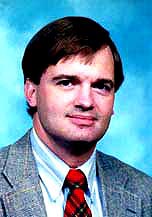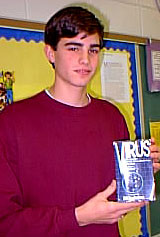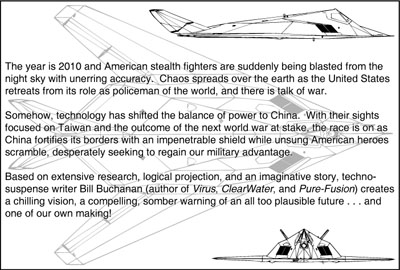Major Works
- Making Waves (2020)
- A Little Girl’s Gift (2020)
- Implosion (2019)
- Technology Wars (2005)
- Pure Fusion (2004)
- Clearwater (2000)
- Virus (New York: The Berkeley Publishing Group, February. 1997)
Bill Buchanan: A Biography
by Adam Murrah (SHS)
Bill Buchanan, the author of Virus, was born in Mobile, Alabama on January 23, 1953. He grew up in Meridian, Mississippi, and graduated from Meridian High School in 1971. As Buchanan recalls, he was an “O.K. student,” but isn’t sure what his teachers would say about that (Buchanan Interview).
Buchanan went to Mississippi State University (MSU) in Starkville, Mississippi. While studying electrical engineering, he helped develop a side-looking prototype radar designed to penetrate foliage. He graduated from MSU in 1975. Before coming to MSU, Buchanan had been a captain in the U. S. Air Force’s Electronic Systems Division. He is now an engineer with Bell Laboratories in Hampstead, New Hampshire (Geuder).
Buchanan first became interested in writing when President Reagan announced in 1983 his plans for the Strategic Defense Initiative. Buchanan wanted to raise public awareness about how dangerous the Star Wars program could be. At first Buchanan thought President Reagan had just been given some bad advice, but over the years his opinion has changed.
He learned the most important things about writing from his family, friends, and his church while he was growing up in Mississippi. The technology is neat, but people remember, feel for, and relate to the people (characters) in a story (Buchanan).
Buchanan’s favorite author changes over time so he’s always looking for a new one. His current favorite fiction writers are Payne Harrison, Storming Intrepid; Eugene Burdick and Harvey Wheeler, Fail-Safe; Michael Crichton, The Andromeda Strain; Stephen Coonts, Flight of the Intruder; Tom Clancy, The Hunt for Red October ; Gerry Carroll, North SAR; and Alan Dean Foster, Alien. His favorite non-fiction author is Brian W. Kernighan, The UNIX Programming Environment, The AWK Programming Language, and The C Programming Language . Out of all these authors the ones that influenced Buchanan the most were Payne Harrison’s Storming Intrepid, which taught Buchanan how to organize, format, and tell the story Virus. Eugene Burdick and Harvey Wheeler showed Buchanan what he wanted to do with his novel, which was to raise public awareness about the Star Wars program. (This is much like Eugene Burdick and Harvey Wheeler’s book Fail-Safe because it raised public awareness on accidental nuclear war.) Buchanan wanted to look like a Brian Kernighan UNIX programming manual. In other words, he wanted the reader to be able to tell if it was computer input (slanted letters) or computer output (typewriter-style characters) (Buchanan interview).
Bill Buchanan is now working on a second novel, Clear Water, another techno thriller about submarines. In Buchanan’s future he hopes to become a full-time writer and move back to Wren, Mississippi, with his wife Janet and his daughters, Amy and Laura, and write on his grandmother’s farm. “That would be fun,” he says (Wagnon).
Date of interview and above biography: 1997.
2008 UPDATE:
Bill Buchanan moved back to Starkville, Mississippi, in 2004 and began working with the U.S. military as an electrical engineer at Mississippi State University at CAV. Before joining the university, he worked for Bell Labs developing equipment for data and telephone networks in New Hampshire. He finished another novel called Technology Wars and is currently working on a three act play to be called Vanishing Points, which according to Buchanan, could be called “The invisible man versus three mile island. ” Buchanan has left CAV at Mississippi State. No information is available as to current residence.
From Bill Buchanan to Adam Murrah (SHS)
February 21, 2005
“Technology Wars was written as a cautionary tale, a story dramatizing the fallout from the globalization of American industry, our unbridled pursuit of foreign markets without regard for national security at home. Writing from an industry insider’s point of view—I worked for Bell Labs twenty years—this story shows a telecommunications equipment company doing whatever it takes to gain a market foothold in China. Although financing and building new factories on the mainland are required as a prerequisite before entering their market, Technology Wars deals with the transfer of technology from the United States to these factories in China where it’s soon turned around and used against us.
This story was inspired by Kelly Johnson, one of my life-long heroes, the founder of Lockheed’s Skunk Works and father of the SR-71 Blackbird spy plane. In his autobiography, he writes “The technological battles of today will determine the outcome of any future world war. It will be won with new weapons… Computer capability will be the most important element… We must not sell our technology… our best electronic gear. In the battle for technology… our defenses have been endangered by… our failure to stop technology transfer.”
Therein lies the motivation behind this story, for in Technology Wars, our failure to stop our communications and computer technology transfer to China endangers us all.
And if this practice continues unchecked, people we care about are going to get killed.”
Peanuts Cartoon
When Buchanan first started on his novel, he didn’t have much luck. Some of his friends made up this Peanuts comic strip to tease him about his first tries at writing Virus.
Reviews
A Review of Virus
by Adam Murrah (SHS)
Virus by Bill Buchanan is about a super virus that is uploaded into a space station that controls DEWSATs (Directed Energy Weapon SATellites). Each DEWSAT was an orbiting counterstealth weapon system, a satellite that could detect and destroy stealth missiles and aircraft from low earth orbit (Buchanan 11).
“The story revolves around the SDI (Strategic Defense Initiative) program in the U.S. and future computer technology. Reviewer Millett says that “Buchanan did his homework and has enough insight into computer systems that the story was believable, and downright frightening. Even though you thought you knew what would happen next, there were more than enough ‘GOT YA’S’ thrown in to keep the suspense up” (Millett).
Adam Murrah (SHS)
Buchanan says that most of the characters in the book are based on different people he’s met throughout the years. The bad characters are from his reading about the history of the middle east and were the most difficult to think like and write about. The good characters are from people he has learned about in books he has read, and people he has known, or would like to know. The technology characters like the DEWSATs and PAM (supervises) came from reading and his work experience, starting first with Mississippi State, NASA, the U.S. Air Force, and Bell Labs (Buchanan Interview).
The story takes place in the year 2014. Brilliant-class weapons have replaced conventional smart technology,. However, the smarter – more chatty – the weapon system, the more susceptible to infection (Buchanan Interview). In 2014, computers are everywhere. They have become very smart and even a little scary. The computers run most everything including aircraft, space stations, DEWSATs, and so many other things its not funny. They do all of this without human assistance, only permission (Buchanan).
PAM, an extremely smart virus worms its way into the United States strategic defense system causing the country’s own antimissile lasers to target commercial jetliners, holding the nation and the world hostage (Wagnon) and will not be shutdown without a fight. By taking over the Space Stations Freedom and Hope and the DEWSATs, PAM is virtually unstoppable. Many things are tried to regain control, but they all fail. After trying to regain control with Black Hole, a test aircraft, and failing, there was only one more chance left,–Hell Fire, one of the best aircraft’s on the face of the Earth (Buchanan).
The reader will need a bit of computer understanding to get the full feel of the book, but even if the reader is not computer literate, he will find it a good book. In conclusion, Virus is an exciting trip through the up and coming future of the computer world, and is a must for any sci-fi fan.
An E-mail Interview with Bill Buchanan (1997)
by Adam Murrah (SHS)
Is the book, even though fiction, based on your life or someone you know?
Some of the characters in the book, the fundamentally bad ones, are based on people I learned of through reading history about the Middle East. These people were scary and by far the most difficult to think like and write about. The cast of good characters are composites of people I learned about through books and would have liked to know plus people I have known.
The technology characters such as Hell Fire, the DEWSAT’S, and PAM came from reading and my work experience, starting first with Mississippi State, NASA, the U.S. Air Force, then finally Bell Labs.
Who is your favorite author?
My favorite author changes over time, some haven’t written much lately, some have passed away, so I’m always looking. If you have any favorites, please let me know. (See biography above for actual books Buchanan mentioned).
What author do you think has influenced you the most?
Payne Harrison’s Storming Intrepid taught me how to organize, format, and tell the story Virus. He thinks about a story as a sequence of well-crafted scenes, sorted in time, carefully threaded together and turns out, that’s the way I think about a story as well.
Eugene Burdick and Harvey Wheeler showed me what I wanted to do (raise public awareness) was possible to achieve with a novel. Their novel, Fail-Safe, was a somber warning about the dangers of accidental nuclear war and it raised public awareness. Virus is intended to be a warning about the dangers of Star Wars, President Reagan’s original proposal for our satellite-based system global missile defense system. Whether or not it will make a difference, only time will tell. The point of the story is that this satellite-based system is more complex and prone to sabotage than most people would ever imagine. Further, if we take short cuts when we deploy this system, if we don’t do it right, people we care about are going to get killed.
Finally, I hoped to make Virus “look like” a Brian Kernighan UNIX programming manual; that is to say I wanted to use his text conventions consistently throughout the book. The reason is that he encodes information into the appearance of his words. For example, you can look at a line in any Kernighan book and recognize if it is computer input (typed in) or computer output (printed out on screen). In general, anything you type into your keyboard is printed in slanted letters, computer output is printed in typewriter-style characters, and explanations are always written in italics.
Why did you decide to write about a killer super virus in your novel Virus?
We develop the smartest weapons in the world, and on the surface that comes as no surprise. Brilliant-class weapons have replaced conventional smart technology when Virus takes place in 2014, but the smarter–more chatty–the weapon system, the more susceptible to infection. This vulnerability is not clear to most people, but once you think about it, it stands to reason. As Mason told the President on page 414, our brilliant-class weapon systems are more susceptible to viral infections than those of our enemies. This is a fact, and to deny this reality is to invite disaster. PAM is scary and I believe her development is inevitable.
When did you become interested in writing? Was there something in particular that got you interested?
1983, once President Reagan announced his plans for the Strategic Defense Initiative. At fist I thought President Reagan had been given bad advice by technically credible people, but over the years, my opinion has moderated.
What kind of student were you in high school?
I’m not sure, really, probably O.K., but no star. I don’t know what my high school teachers would say. I know a few have good memories of me, but I can’t speak for very many.
How has Mississippi or living in Mississippi influenced your writing?
Nearly everything I ever learned about people, the most important stuff a write must know, I learned from my family, friends, and church growing up in Mississippi.
In a technical thriller, people usually think the technology is cool, but everyone quickly forgets it. The technology is neat, but people remember, feel for, and relate to the people (characters) in your story.
Buchanan’s Advice to Future Writers
Email interview by Adam Murrah (SHS)
First, Buchanan encourages students to stay in school. He also says that “what really matters in life is people. I encourage anyone in school today to focus on learning people skills. Oral communication, writing, and human interaction skills are among the most important.”
“And stay in school. If you want the chance to do what you’ve always wanted to do for a living someday, school is more important than you can possibly imagine. In all probability, high school, college, and your teachers will help you get where you want to go in life.”
During the interview Buchanan was asked if he had any advice for future writers. Here is some of what he had to say:
Never lose heart. If you’ve always wanted to write a novel, learn to write, speak from your heart, and go for it. Eventually, your carefully crafted scenes, gingerly threaded together, recreate the magic. And your story is born…
I’m serious about this. If I can do it, you can too, but I don’t mean to say it’s easy. You’ll get your feelings hurt along the way, but rejection is s a risk of writing. If you have a story you believe in with something to say, give it your best shot. With perseverance, writing is a wonderful adventure of discovery, one of the most satisfying things I’ve ever done.
Believe in your story, continue to improve it, be persistent and never lose heart. Once it’s good enough, it’ll get recognized.
In a way, stories become your children. You’ll care about them more than you’d ever dream possible.
Related Websites
- Various short reviews on Amazon book site.
- Amazon.com has rave reviews for Clearwater.
- Buchanan explains Pure Fusion on Amazon.com
- Alum’ Proves ’em wrong: Engineers can write by Bill Wagnon (1997)
Bibliography
- Buchanan, Bill. Interview by Adam Murrah. December 2, 1997.
- Buchanan, Bill. (1997). Virus. New York: The Berkeley Publishing Group.
- Geuder, Meredith. (1997, June 23). Virus author to speak (press release).
- http://msuinfo.ur.msstate.edu/
- Millett, Clint. Virus: A Book Review. [Review of Virus].
- Wagnon, Bill. (1997, Fall). Alum proves ’em wrong: Engineers can write. Alumnus. 10-11.




